Do you have a question about the Miele KFN 8862 SD and is the answer not in the manual?
Details on the optional Miele@home system for remote appliance monitoring and control.
Guidelines for the safe and recyclable disposal of appliance packaging materials.
Instructions for the safe and environmentally sound disposal of the old refrigerator unit.
Defines the intended domestic use of the appliance and warns against misuse.
Information on coolant safety, electrical connection safety, and potential hazards.
Advice on choosing an optimal installation location for energy efficiency.
Guidance on setting thermostat temperatures to minimize energy consumption.
Practical tips on door usage, food storage, and cooling habits for energy efficiency.
How proper defrosting contributes to maintaining appliance energy efficiency.
Instructions for first-time use, switching the appliance on, off, and managing individual sections.
How to activate or deactivate the safety lock to prevent accidental changes.
Procedures for safely switching off the appliance during extended absences like holidays.
How to set and adjust temperatures for refrigerator and freezer sections independently.
Interpreting temperature readings, flashing displays, and conditions causing fluctuations.
Steps to modify the brightness level of the appliance's temperature display.
How the alarm system functions for temperature deviations or door openings.
How to switch off alarms early or manage door alarm notifications.
Using Super cool for rapid chilling of food and drinks in the refrigerator.
Best practices for quick freezing to preserve food quality and nutrients.
Utilizing Super freeze for efficient freezing of larger quantities of food.
Enhancing air circulation for even cooling and specific environmental conditions.
Utilizing different temperature zones within the refrigerator for optimal food storage.
Guidelines for packaging and storing food to prevent odors, drying, and contamination.
Specific advice on storing fruits and vegetables, considering gas emissions.
Instructions for moving shelves, door shelves, and bottle dividers for flexible storage.
Understanding and adhering to the appliance's freezing capacity limits.
Checking packaging, dates, and transport conditions for stored frozen items.
Tips on suitable foods, blanching vegetables, and packaging for home freezing.
Recommended materials and techniques for effective food packaging to prevent freezer burn.
Using the freezer calendar and marker system to track frozen food storage duration.
Methods for safely defrosting various types of frozen food.
Procedures for rapidly cooling drinks and making ice cubes.
Utilizing the freezer tray for small items and the cool pack for power outages.
Explanation of the automatic defrosting process for the refrigerator compartment.
Description of the "Frost free" system for automatic freezer defrosting.
Warnings against abrasive cleaners and precautions for cleaning electronic units.
Step-by-step guide for cleaning the appliance's casing, interior, and accessories.
Care instructions for the metal grille, ventilation gaps, and door seals.
Troubleshooting steps for refrigerators or freezers not cooling or cooling too much.
Solutions for door opening difficulties and frequent appliance cycling.
Addressing frozen food thawing, food freezing together, and alarm triggers.
Interpreting display errors, handling power cut effects, and indicator light issues.
Diagnosing and resolving issues with interior lights and wet refrigerator floors.
Identifying typical sounds like humming, gurgling, and clicking from the appliance.
Solutions for common sources of rattling or vibrating sounds, such as uneven leveling.
Specific safety and connection guidelines for the UK electrical system.
Guidelines for handling non-rewireable plugs, fuse replacement, and earthing.
Recommendations for choosing a location and ensuring adequate ventilation for optimal performance.
Understanding the appliance's operating temperature range and environmental suitability.
Steps for physically placing and leveling the appliance correctly.
Instructions for detaching and reattaching door handles during hinging changes.
Step-by-step guide to reversing the door swing direction for installation flexibility.
Details on the optional Miele@home system for remote appliance monitoring and control.
Guidelines for the safe and recyclable disposal of appliance packaging materials.
Instructions for the safe and environmentally sound disposal of the old refrigerator unit.
Defines the intended domestic use of the appliance and warns against misuse.
Information on coolant safety, electrical connection safety, and potential hazards.
Advice on choosing an optimal installation location for energy efficiency.
Guidance on setting thermostat temperatures to minimize energy consumption.
Practical tips on door usage, food storage, and cooling habits for energy efficiency.
How proper defrosting contributes to maintaining appliance energy efficiency.
Instructions for first-time use, switching the appliance on, off, and managing individual sections.
How to activate or deactivate the safety lock to prevent accidental changes.
Procedures for safely switching off the appliance during extended absences like holidays.
How to set and adjust temperatures for refrigerator and freezer sections independently.
Interpreting temperature readings, flashing displays, and conditions causing fluctuations.
Steps to modify the brightness level of the appliance's temperature display.
How the alarm system functions for temperature deviations or door openings.
How to switch off alarms early or manage door alarm notifications.
Using Super cool for rapid chilling of food and drinks in the refrigerator.
Best practices for quick freezing to preserve food quality and nutrients.
Utilizing Super freeze for efficient freezing of larger quantities of food.
Enhancing air circulation for even cooling and specific environmental conditions.
Utilizing different temperature zones within the refrigerator for optimal food storage.
Guidelines for packaging and storing food to prevent odors, drying, and contamination.
Specific advice on storing fruits and vegetables, considering gas emissions.
Instructions for moving shelves, door shelves, and bottle dividers for flexible storage.
Understanding and adhering to the appliance's freezing capacity limits.
Checking packaging, dates, and transport conditions for stored frozen items.
Tips on suitable foods, blanching vegetables, and packaging for home freezing.
Recommended materials and techniques for effective food packaging to prevent freezer burn.
Using the freezer calendar and marker system to track frozen food storage duration.
Methods for safely defrosting various types of frozen food.
Procedures for rapidly cooling drinks and making ice cubes.
Utilizing the freezer tray for small items and the cool pack for power outages.
Explanation of the automatic defrosting process for the refrigerator compartment.
Description of the "Frost free" system for automatic freezer defrosting.
Warnings against abrasive cleaners and precautions for cleaning electronic units.
Step-by-step guide for cleaning the appliance's casing, interior, and accessories.
Care instructions for the metal grille, ventilation gaps, and door seals.
Troubleshooting steps for refrigerators or freezers not cooling or cooling too much.
Solutions for door opening difficulties and frequent appliance cycling.
Addressing frozen food thawing, food freezing together, and alarm triggers.
Interpreting display errors, handling power cut effects, and indicator light issues.
Diagnosing and resolving issues with interior lights and wet refrigerator floors.
Identifying typical sounds like humming, gurgling, and clicking from the appliance.
Solutions for common sources of rattling or vibrating sounds, such as uneven leveling.
Specific safety and connection guidelines for the UK electrical system.
Guidelines for handling non-rewireable plugs, fuse replacement, and earthing.
Recommendations for choosing a location and ensuring adequate ventilation for optimal performance.
Understanding the appliance's operating temperature range and environmental suitability.
Steps for physically placing and leveling the appliance correctly.
Instructions for detaching and reattaching door handles during hinging changes.
Step-by-step guide to reversing the door swing direction for installation flexibility.
| Temperature Zones | 2 |
|---|---|
| Control Type | Electronic |
| Number of Doors | 2 |
| Climate Class | SN-T |
| Reversible Door | Yes |
| Adjustable Shelves | Yes |
| Door Alarm | Yes |
| Super Cool Function | Yes |
| Super Freeze Function | Yes |
| Product Type | Fridge-Freezer |
| Freezer Star Rating | 4 stars |
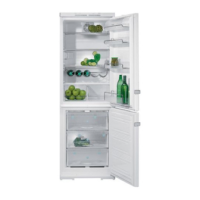
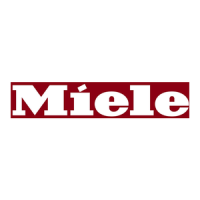

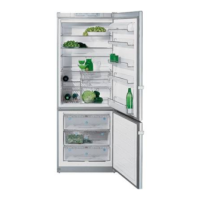
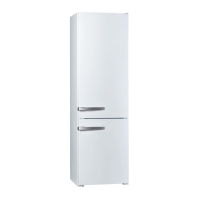






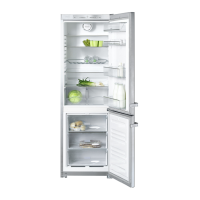
